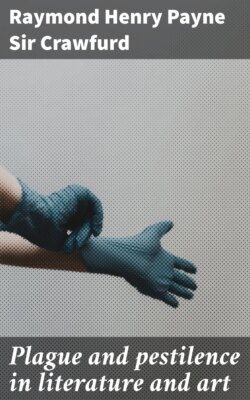Plague and pestilence in literature and art

Реклама. ООО «ЛитРес», ИНН: 7719571260.
Оглавление
Raymond Henry Payne Sir Crawfurd. Plague and pestilence in literature and art
Plague and pestilence in literature and art
Table of Contents
PREFACE
LIST OF PLATES
CHAPTER I
CHAPTER II
CHAPTER III
CHAPTER IV
CHAPTER V
CHAPTER VI
CHAPTER VII
CHAPTER VIII
CHAPTER IX
CHAPTER X
CHAPTER XI
CHAPTER XII
CHAPTER XIII
APPENDIX[200]
Отрывок из книги
Raymond Henry Payne Sir Crawfurd
Published by Good Press, 2021
.....
The arrows of pestilence have sunk deep into the tissue of many languages. Practically all the Hebrew words for plague (Maggefah, Negef, Naga, Makkah) indicate a blow. Our English ‘plague’ is derived through the Latin plaga from the Greek πληγή, a blow: so too the German plage. The French fléau—a flail or a plague—embodies the same idea of a blow, and is derived from the Latin flagellum and the Greek θλίβω. To-day even physicians must needs call the poisons of pestilence ‘toxines’, as though they were arrow-poisons discharged from a bow (τόξον from τυγχάνω = I hit). The Arabians speak of being ‘stung ’ or ‘pricked’ with plague, recalling respectively the serpents and the arrows of pestilence.
Passing allusion has been made above to the plagues of Pharaoh: it remains only to be said that there is now pretty general agreement that these ten plagues represent merely the seasonal variations, to which Egypt is peculiarly liable, magnified in Jewish oral tradition. Perhaps the last plague, the death of the first-born, at the April of the exodus (circa 1220 b.c.) may have been a true pestis puerorum, falling with chief severity on those who lacked the immunity afforded by a previous epidemic. It was the incursion of Libyans and of the nations of the Greek seas into Egypt, at least as much as the Biblical plagues, that enabled the Israelitish serfs to make good their escape.
.....